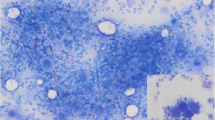Summary
A 20-year-old man suffering from Crohn's disease developed coma and generalized seizures following ileocecal resection. During postoperative parenteral feeding he received xylitol in an unusually high concentration. CT examinations a few days before death showed intense hypodensity and swelling of brainstem and basal ganglia and increasing triventricular dilatation. Autopsy revealed, mainly in the brainstem and cerebellum, a destruction of intracerebral, intracerebellar and leptomeningeal vessel walls by birefringent crystals (probably calcium oxalate), an early inflammatory reaction and severe brain edema with final tonsillar herniation. The same crystalloid deposits were found in the kidneys.
Similar content being viewed by others
References
Arzneimittelkommission der Deutschen Ärzteschaft (1972) Dosierungsgrenzen bei der Infusion von Zuckeraustauschstoffen beachten!. Dtsch Ärztebl 69: 3399
Bednar B, Jirasek A, Stejskal J, Chytil M (1961) Die sekundäre dramische Oxalose. Zentralbl Allg Pathol 102: 289–297
Beppu T, Mori S, Omoto R, Nishi T, Oya G (1975) Secondary oxalosis after ileocecal resection. Report of two autopsy cases and review of the literature. Nippon Shokakibyo Gakkai Zasshi 72: 520–521
Bungener W (1973) Kalziumoxalatausfällung in Niere und Gehim nach hochdosierter Xylitinfusion. Zentralbl Allg Pathol 117, 204
Chou JY, Richardson KE (1978) The effect of pyrazole on ethylene glycol toxicity and metabolism in the rat. Toxicol Appl Pharmacol 43: 33–44
Clav KL, Marphy RC (1977) On the metabolic acidosis of ethylene glycol intoxication. Toxicol Appl Pharmacol 39: 39–49
Dölp R, Paulini K (1976) Oxalatbildung nach parenteraler Fmahrung mit Aminosäuren und Xylit bei einem polytraumarisierten Patienten. Int J Vitam Nutr Res [Suppl] 15: 228–233
Evans GW, Phillips G, Mukherjee TM, Snow MR, Lawrence IR, Thomas DW (1973) Identification of crystals deposited in brain and kidney after xylitol administration by biochemical, histochemical and electron diffraction methods. J Clin Pathol 26: 32–36
Ecascino JA, Vanamee P, Rosen PP (1970) Renal oxalosis and azotemia after methoxyflurane anesthesia. N Engl J Med 283: 679–684
Gambardella RL, Richardson KE (1978) The formation of oxalate from hydroxypyruvate, serine, glycolate and glyoxylate in the rat. Biochim Biophys Acta 544: 315–328
Haqqani MT (1977) Crystals in brain and meninges in primary hyperoxaluria and oxalosis. J Clin Pathol 30:16–18
Hodgkinson A (1977) Oxalic acid in biology and medicine. Academic Press, London New York San Francisco
Ludwig B, Schindler, E, Bohl J, Pfeiffer J, Kremer G (1982) Xylit-induzierte reno-cerebrale Oxalose. 18. Jahrestagung der Deutschen Gesellschaft für Neuroradiologie, Hamburg
Maier W (1983) Cerebral computed tomography of ethylene glycol intoxication. Neuroradiology 24:175–177
Nissen P, Jester HG, Gille J, Kuge R (1973) Primär endogene Oxalose mit klinisch manifestem Gefäßbefall. Dtsch Med Wochenschr 98:1714–1715
Parry MF, Wallach R (1974) Ethylene glycol poisoning. Am J Med 57:143–150
Peiffer J (1979) Komplikationen bei Infusionsbehandlung. Zentralbl Allg Pathol 123:145–147
Pons AC, Custer PR (1946) Acute ethylene glycol poisoning; a clinico-pathologic report of eighteen fatal cases. Ann J Med Sci 211:544–552
Schröder R, Féaux de Lacroix W, Franzen U, Klein PJ, Müller W (1974) Therapie-bedingte Form einer reno-cerebralen Oxalose? Acta Neuropathol (Berl) 27:181–184
Schröder R (1980) Storungen im Oxalsäurestoffwechsel bei parenteraler Ernährung mit Xylit. Dtsch Med Wochenschr 105:997–1001
Schultis K (1971) Xylit als Glucoseaustauschstoff bei der gestörten Glucoseassimilation im Postaggressionssyndrom. Eine Übersicht über tierexperimentelle und klinische Studien. Z Ernährungswiss [Suppl] 11:87–96
Scully RF, Galdabini JJ, McNeely BU (1979) Case records of the Massachusetts General Hospital, case 38-1979. N Engl J Med 301:650–657
Terlinsky AS, Grochowski J, Geoly KI, Stauch BS, Hefter L (1981) Identification of atypical calcium oxalate crystalluria following ethylene glycol ingestion. Am J Clin Pathol 76:233–226
Thomas DW, Edwards JB, Edwards RG (1970) Examination of xylitol. N Engl J Med 283:437–445
Thomas DW, Edwards JB, Gilligan JE, Lawrence JR, Edwards RG (1972) Complications following intravenous administration of solutions containing xylitol Med J Aust 1: 1238–1246
Zarembski PM, Hodgkinson A, Parsons FM (1966) Elevation of the concentration of plasma oxalic acid in renal failure. Nature 212:511–512
Zarembski PM, Hodgkinson A (1967) Plasma oxalic acid and calcium levels in oxalate poisoning. J Clin Pathol 20:283–285
Author information
Authors and Affiliations
Rights and permissions
About this article
Cite this article
Ludwig, B., Schindler, E., Bohl, J. et al. Reno-cerebral oxalosis induced by xylitol. Neuroradiology 26, 517–521 (1984). https://doi.org/10.1007/BF00342692
Received:
Issue Date:
DOI: https://doi.org/10.1007/BF00342692




